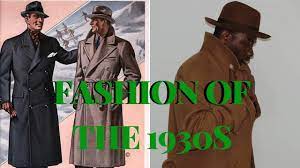Exploring the Timeless Elegance of 1930s Men’s Fashion
The Timeless Elegance of 1930s Men’s Fashion
The 1930s was a decade marked by economic hardship and social change, and men’s fashion reflected these shifting times. Despite the challenges of the Great Depression, men still sought to present themselves with style and sophistication.
One of the defining features of 1930s men’s fashion was the emphasis on tailored suits. Suits were a staple in every man’s wardrobe, with wide shoulders, a nipped waist, and wide-leg trousers creating a strong silhouette. Fabrics like wool and tweed were popular choices, reflecting both practicality and elegance.
Accessories played a crucial role in completing a man’s look during this era. Wide-brimmed fedora hats were a common sight, adding a touch of sophistication to any outfit. Ties were often worn wide and long, adding a pop of colour or pattern to an otherwise muted ensemble.
Casual wear also saw some evolution during the 1930s. Knitted polo shirts became popular for more relaxed occasions, paired with high-waisted trousers for a smart yet laid-back look. Sweaters made from wool or cashmere provided warmth and style during colder months.
Footwear was another important aspect of men’s fashion in the 1930s. Oxfords and brogues were favoured for their timeless appeal and versatility, suitable for both formal and casual occasions. Leather loafers also gained popularity as a comfortable yet stylish option.
In conclusion, 1930s men’s fashion was characterised by tailored suits, sophisticated accessories, and attention to detail. Despite the challenges of the era, men found ways to express their personal style through their clothing choices. The legacy of 1930s fashion continues to inspire modern menswear trends, showcasing the enduring appeal of classic elegance.
Decoding the Dapper: Key Trends in 1930s Men’s Fashion and Style
- What were the popular suit styles in 1930s men’s fashion?
- Which accessories were commonly worn by men in the 1930s?
- What fabrics were popular for men’s suits in the 1930s?
- How did casual wear evolve for men during the 1930s?
- What types of footwear were fashionable for men in the 1930s?
What were the popular suit styles in 1930s men’s fashion?
In the realm of 1930s men’s fashion, popular suit styles exuded a distinct blend of sophistication and masculinity. The era was defined by tailored suits with wide shoulders, a nipped waist, and wide-leg trousers, creating a strong and commanding silhouette. Fabrics such as wool and tweed were commonly used, reflecting both practicality and elegance in equal measure. These suits were often accessorised with wide-brimmed fedora hats and ties worn wide and long, adding a touch of flair to the overall ensemble. The popularity of these suit styles during the 1930s showcased a harmonious balance between traditional tailoring and modern trends, embodying the timeless elegance that continues to inspire men’s fashion today.
Which accessories were commonly worn by men in the 1930s?
In the 1930s, men embraced a variety of accessories to complement their stylish ensembles. One of the most common accessories worn by men during this era was the wide-brimmed fedora hat, adding a touch of sophistication to their outfits. Ties played a significant role in men’s fashion, often worn wide and long to introduce colour and patterns to their attire. Additionally, leather oxford or brogue shoes were popular choices for footwear, offering a blend of timeless style and versatility. These accessories not only enhanced the overall look but also reflected the attention to detail and elegance that defined 1930s menswear.
What fabrics were popular for men’s suits in the 1930s?
During the 1930s, men’s suits were commonly crafted from a variety of high-quality fabrics that reflected both elegance and durability. Wool was a popular choice for its versatility and ability to drape well, creating a polished look. Tweed, known for its warmth and textured appearance, was another favoured fabric for suits during this era. Additionally, flannel and gabardine were popular choices for men seeking a blend of comfort and sophistication in their suiting options. These fabrics not only provided practicality in the face of economic challenges but also contributed to the timeless style that defined 1930s menswear.
How did casual wear evolve for men during the 1930s?
During the 1930s, casual wear for men underwent a notable evolution, reflecting the changing social dynamics of the era. Knitted polo shirts emerged as a popular choice for more relaxed occasions, providing a stylish yet comfortable alternative to formal attire. Paired with high-waisted trousers, these polo shirts offered a smart and laid-back look that resonated with the desire for both elegance and practicality. Additionally, sweaters made from luxurious fabrics like wool or cashmere became essential pieces for colder months, combining warmth with sophistication in casual settings. The evolution of casual wear in the 1930s demonstrated a shift towards more relaxed yet refined menswear options, showcasing a blend of comfort and style that continues to influence contemporary fashion trends.
What types of footwear were fashionable for men in the 1930s?
In the 1930s, men’s footwear played a significant role in defining their overall style. Fashionable choices for men’s shoes during this era included classic Oxfords and brogues, known for their timeless appeal and versatility across formal and casual settings. These leather lace-up shoes exuded sophistication and complemented the tailored suits that were a staple of 1930s menswear. Additionally, leather loafers emerged as a popular choice, offering a blend of comfort and style for men seeking a more relaxed yet refined look. The footwear trends of the 1930s reflected an emphasis on quality craftsmanship and enduring elegance that continues to influence modern fashion sensibilities.
